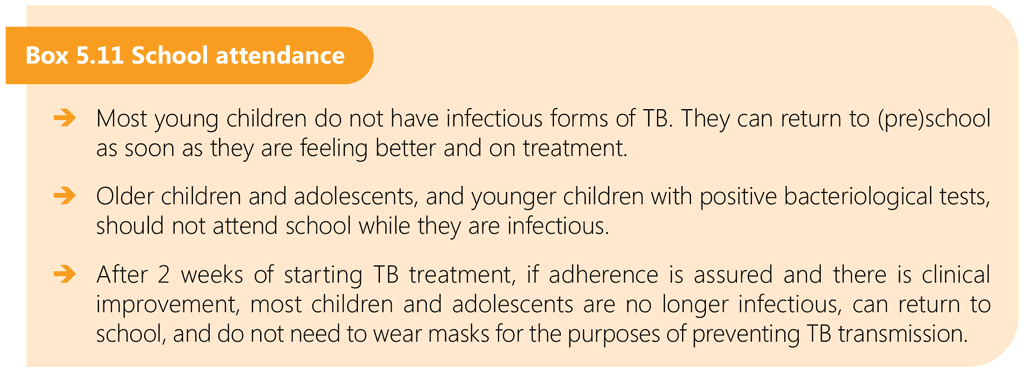Book traversal links for 5.2.12. Follow-up and monitoring of children and adolescents on TB treatment
All children and adolescents initiated on TB treatment should undergo a monitoring assessment at the following intervals as a minimum:
- HIV-negative children and adolescents: 2 weeks and 4 weeks after the start of treatment, at the endof the intensive phase (after 2 months), and then every 2 months until completion of treatment at 4 months or 6 months (depending on regimen used).
- Children and adolescents living with HIV: 2 weeks and 4 weeks after the start of treatment, and then every month until completion of treatment at 4 months or 6 months (depending on regimen used). Children with advanced HIV should be monitored more frequently in accordance with existing recommendations for advanced HIV care (78).
- Clinical monitoring requirements for the shorter regimen are the same as for the 6-month regimen. Treatment outcomes are determined at the end of treatment, at 4 months for the short regimen and at 6 months for the standard regimen. The definition of successful treatment completion takes into account that the expected number of doses is reduced in the shorter regimen.
Monitoring should include the following as a minimum:
- Assess for resolution or persistence of TB-related symptoms, symptoms of side-effects of medicines, and other symptoms.
- Measure weight – dosages should be adjusted depending on weight gain.
- Assess adherence – review the treatment card and discuss with the patient, caregivers and other treatment supporters.
- Follow-up sputum samples for smear microscopy 2 months after the start of treatment and at treatment completion may be collected from any child who was Xpert MTB/RIF-positive, Xpert Ultra-positive, smear-positive or culture-positive at diagnosis if the treatment site has capacity to perform the test. Symptomatic improvement and weight gain are, however, more valuable markers of treatment success or failure (72). If a follow-up smear is positive, the patient should complete additional investigations to assess for drug resistance (Xpert MTB/RIF or Ultra, TB culture and DST or molecular tests for drug resistance) and other causes of poor treatment response (see Box 5.12). In children who cannot expectorate, a repeat specimen at the end of treatment is not necessary if the specimen collected at 2 months is negative.
- Repeat sample collection at 2 months in children with unconfirmed TB is not indicated unless there is an inadequate clinical response without symptomatic and nutritional improvement.
- Follow-up CXR is not needed if the child is responding well to TB treatment. Children commonly have a slow radiographic response to treatment and may have persistent radiographic abnormalities at treatment completion (6), but this does not mean they are not responding to treatment.

 Feedback
Feedback